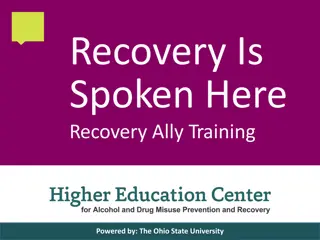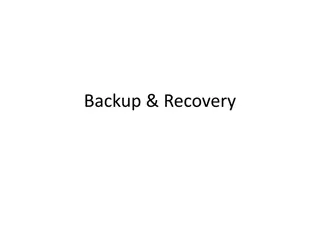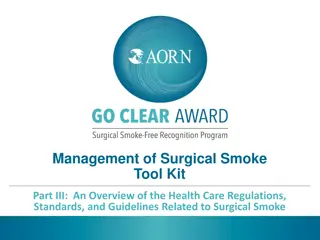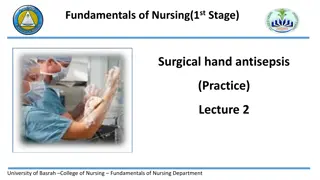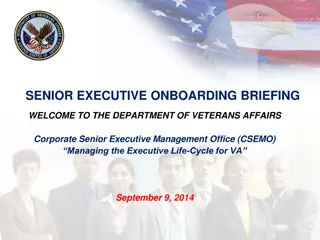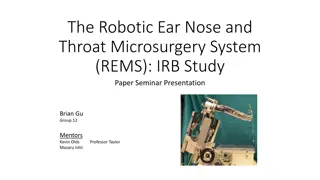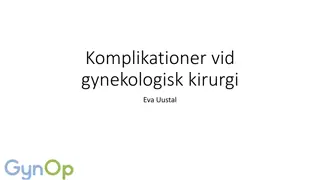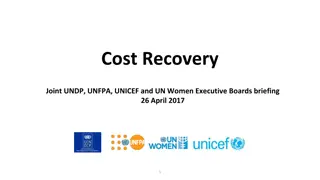Engaging Senior Executives in Improving Surgical Care and Recovery Program
This presentation template aims to engage senior leaders in bridging the gap between management and frontline providers for implementing an Improving Surgical Care and Recovery program successfully. It emphasizes the importance of senior leader participation and provides a structured outline for customizing the presentation. The template covers the purpose, objectives, goals, and strategies for the ISCR initiative, offering guidance on how to involve senior executives effectively. By utilizing this template, hospitals can foster collaboration and drive improvements in patient outcomes and perioperative processes.
Download Presentation

Please find below an Image/Link to download the presentation.
The content on the website is provided AS IS for your information and personal use only. It may not be sold, licensed, or shared on other websites without obtaining consent from the author. Download presentation by click this link. If you encounter any issues during the download, it is possible that the publisher has removed the file from their server.
E N D
Presentation Transcript
AHRQ Safety Program for Improving AHRQ Safety Program for Improving Surgical Care and Recovery Surgical Care and Recovery Engaging the Senior Executive Presentation Template AHRQ Pub. No. 23-0052 June 2023
Purpose and Use of This Presentation Template Purpose of tool: To engage a senior leader to bridge the gap between senior management and frontline providers and to help garner a system-level perspective on existing safety challenges. Senior leader participation and engagement in the initiative is vital to the success of implementing an Improving Surgical Care and Recovery (ISCR) program. How to use: The suggested outline in this template provides prompts in red font for customizing the presentation for your hospital s ISCR program. You can use the template early on to engage your senior executive, and throughout the initiative to share your progress with him or her to support sustainability. Review the slides to see what information you need to gather to help gauge how long it will take to complete. You can learn more about engaging the senior executive at the Agency for Healthcare Research and Quality s website on the Comprehensive Unit-based Safety Program (CUSP). Note: Delete this slide and the previous slide, and edit or delete red text in the remaining slides, including in the lower right corner, before presenting to your senior executive. The template for your presentation begins on the next slide. Template Presentation for Engaging Senior Executives 2
AHRQ Safety Program for Improving AHRQ Safety Program for Improving Surgical Care and Recovery Surgical Care and Recovery [Hospital Name] Improving Surgical Care and Recovery of Patients: [Service Line] Pathway [Presenter Name] [Date]
Objectives Learn about the AHRQ Safety Program for Improving Surgical Care and Recovery (ISCR) Review the current state of perioperative care at [insert hospital name] Examine changes in process compliance and outcomes over time Discuss next steps for the ISCR initiative ISCR at [Hospital Name] 4
ISCR Goals Goals o Improve patient outcomes o Make perioperative processes more efficient o Make perioperative care more collaborative ISCR at [Hospital Name] 5
Balanced Approach to Adaptive and Technical Work * Comprehensive Unit-based Safety Program (CUSP) ISCR at [Hospital Name] 6
Opportunity To Improve Decrease length of stay1 Reduce adverse events1 Improve patient experience Lower the cost of care1 ISCR at [Hospital Name] 7
Current State [Service line, e.g., colorectal, orthopedic] surgery procedures may have high morbidity (e.g., SSI) and long lengths of stay. Care of [service line] surgery patients is highly variable for: Preoperative education Plan for anesthesia Pain management Fluid resuscitation Resumption of oral intake Mobility An opportunity exists to improve collaboration in the perioperative area among surgery, anesthesiology, and nursing. ISCR at [Hospital Name] 8
ISCR at [Hospital Name] Overview Summarize progress to date. Some examples are listed below. Conducted a gap analysis to identify areas and goals for improvement List the processes that were implemented (e.g., new protocols like presurgical education standardization, shortening preop fasting period, etc.)2,3 o If your ISCR team has implemented some processes and you have data to share, consider sharing some of the examples provided on slide 12 of this template (Titled ISCR at [Hospital Name] Results) Consider inserting team photo ISCR at [Hospital Name] 9
Overview of Gap Analysis & Goal Setting for [Service Line] Surgery Use your Gap Analysis and Goal Setting Form to report your current ISCR service line surgery rates (see below for examples of data to report).* Total number of [service line (e.g., colorectal)] surgery cases done in CY XXXX: Length of stay (mean and median): Unplanned 30-day readmission rate (post-discharge): SSI (deep) rate: SSI (organ space) rate: All-cause inpatient mortality rate: Include any other outcome measure rates you have data for at your institution (e.g., superficial SSI, VTE, patient satisfaction): *The Gap Analysis and Goal Setting Form suggests using the Centers for Disease Control and Prevention s National Healthcare Safety Network (NHSN) registry for these data, but others may be available at your hospital. The surveillance period should be determined using the NHSN operative procedure category. Include comparison to other hospitals if available. ISCR at [Hospital Name] 10
Top Three Goals List your ISCR team s top three goals for the ISCR program at your hospital. These are the goals your ISCR Core Team identified using your latest assessment from the Gap Analysis and Goal Setting Form. 1. Example: Reduce deep incisional SSI rate from 12% (CY 2022) to 7% (CY 2023) for patients undergoing abdominal surgery 2. Goal 2 3. Goal 3 ISCR at [Hospital Name] 11
ISCR at [Hospital Name] Results Insert graphs and/or tables. Examples of what you can share are listed below. Process measure adherence and outcomes (complications, length of stay, readmission) Use bar or line graphs and/or tables to display results that show progress across multiple quarters pre- and post-implementation It s important to not just highlight success but also to point out underperforming areas so leadership knows what needs additional attention ISCR at [Hospital Name] 12
Next Steps Highlight the next steps you plan to take to optimize or sustain ISCR at your hospital. 1. Next Step 1 2. Next Step 2 3. Next Step 3 ISCR at [Hospital Name] 13
Thank You! Please contact [enter point of contact name, email address, and telephone number] with questions. ISCR at [Hospital Name] 14
References 1. Ljungqvist O, de Boer HD, Balfour A, et al. Opportunities and challenges for the next phase of enhanced recovery after surgery: a review. JAMA Surg. 2021;156(8):775-84. doi:10.1001/jamasurg.2021.0586. 2. Stone AB, Yuan CT, Rosen MA, et al. Barriers to and facilitators of implementing enhanced recovery pathways using an implementation framework: a systematic review. JAMA Surg. 2018 Mar 1;153(3):270-9. doi: 10.1001/jamasurg.2017.5565. PMID: 29344622. 3. Ament SMC, Gillissen F, Moser A, et al. Factors associated with sustainability of 2 quality improvement programs after achieving early implementation success. A qualitative case study. J Eval Clin Pract. 2017 Dec;23(6):1135-43. doi: 10.1111/jep.12735. Epub 2017 Apr 20. PMID: 28425574. ISCR at [Hospital Name] 15






